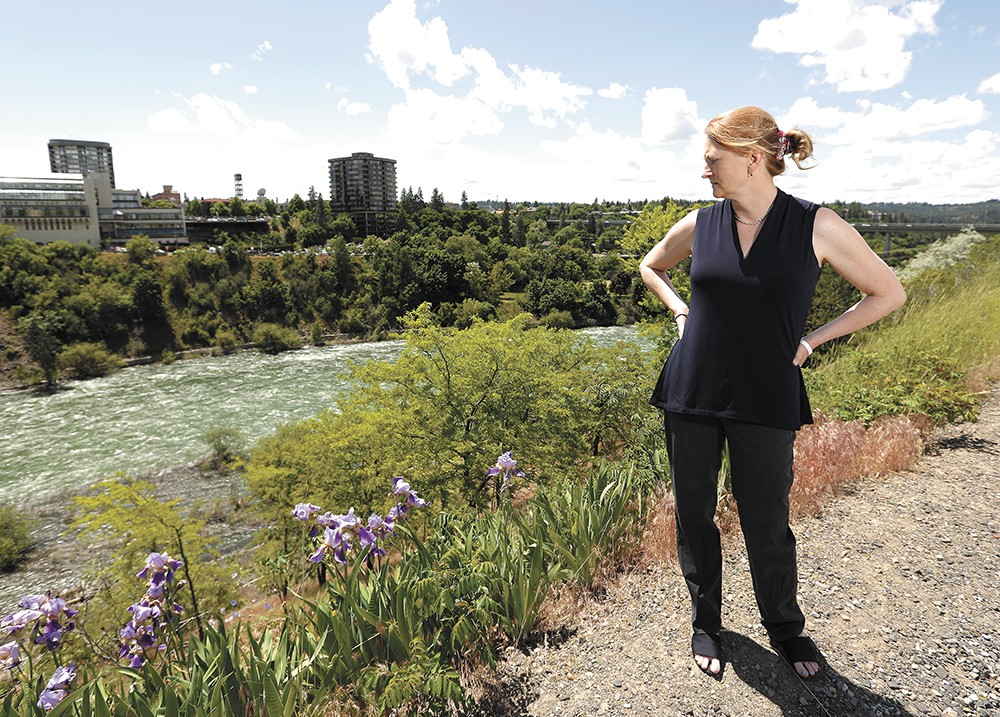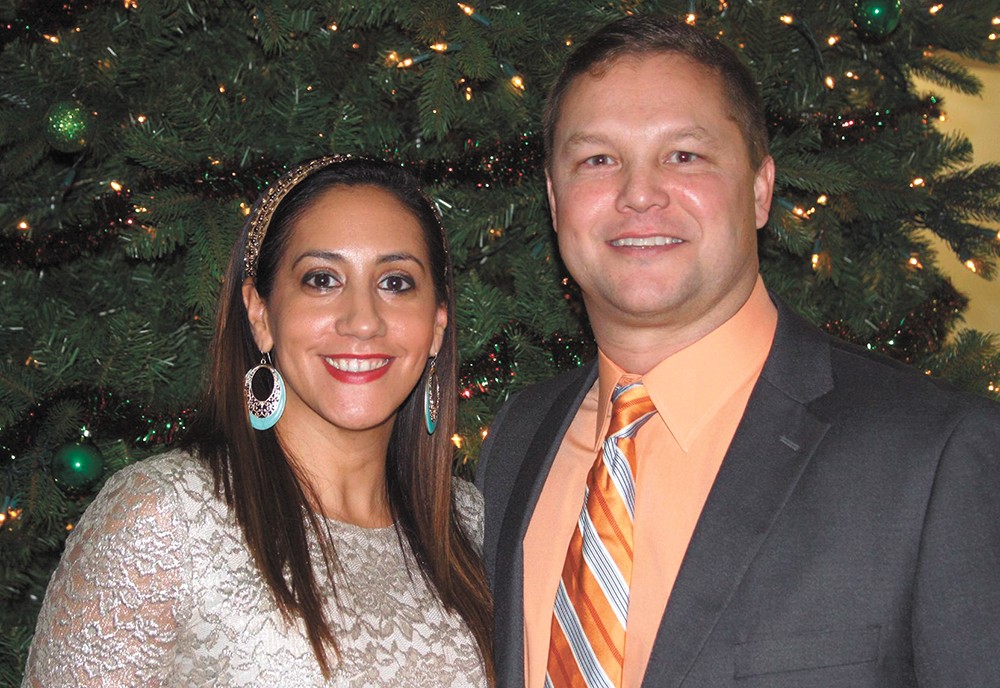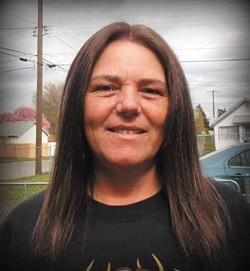
Her husband has been dead for one year, four months and 13 days, but Suzan Marshall won't let go.
She's sitting at her kitchen table last week in front of a stack of papers — autopsies, police reports and her own handwritten notes. More records are stored on her laptop.
These reports and photographs document the lives and deaths of at least 10 people who died in Eastern Washington and North Idaho dating back to 2012. Marshall believes they all have one thing in common: questionable autopsies.
In each case, the Spokane County medical examiners issued official rulings on the cause or manner of death — suicide, homicide, accident, natural causes or undetermined — that had consequences regarding how police and prosecutors pursued their investigation. Family members in each of these cases question the medical examiner's decision, which may have stalled or derailed criminal investigations and left families reeling, with no way to get answers.
This all started when Marshall's husband, John, disappeared.
Dr. John Marshall, chief of surgery at the Mann-Grandstaff Veterans Affairs Medical Center, went missing on Jan. 25, 2016, during an early morning jog. His body was found floating in the Spokane River the next day, and the Spokane County Medical Examiner, Dr. John Howard, ruled that John Marshall had drowned and that it was an accident.
Suzan Marshall, a surgeon herself, disagrees. After reviewing the autopsy and photos of her husband's stiff body, she believes he was severely beaten and dumped in the river. The Spokane police detective investigating his death is also confounded. He writes in his report that John Marshall's body does not look like others that were dragged over the muddy rocks in the river.
The severe bone fracture in his chest and internal bleeding indicate a "takedown move," Suzan Marshall says. His iPod, which was still in his pocket when police pulled him from the river, showed no evidence of water damage, according to an analysis by a digital forensics investigations firm hired by Suzan Marshall. And if he fell from a bridge and tumbled over the falls, "Why wasn't the rest of his body more badly bruised? Why weren't more bones broken?" she asks.
Suzan Marshall has thrown her energy into a hunch that her husband's case wasn't the first. So far, she's looked into several other cases with rulings by Spokane County's forensic pathologists, Howard and Dr. Sally Aiken, that she says are "ludicrous."
Among them is a woman whose body was cut in half and disposed of in black plastic bags. Howard ruled the cause and manner of death as "undetermined." Then there's the woman whose body was found wrapped in a sheet of plastic, bound with duct tape and dumped on the side of the road near Cataldo, Idaho. Howard, who performed the autopsy, says the woman died of a heart attack; the Kootenai County deputy coroner then ruled the manner of death "natural causes."
"The medical examiner's decision on cause and manner of death is critical for law enforcement," says Spokane Police Captain Brad Arleth, who oversees the department's detectives. "We have to meet the legal standard to present a complete case to the prosecutor's office. They're kind of the fulcrum as far as determining those key components of the statute. As an investigator, you're going to use whatever language they give you in charging documents."
Neither of Spokane's two medical examiners, Aiken or Howard, agreed to be interviewed by the Inlander, but Aiken did respond to questions via email.
"The medical examiners make decisions independent of law enforcement, the prosecution or the defense," Aiken writes. "The system is designed with a separation of responsibilities. Law enforcement and the prosecutor will determine what weight they want to afford the medical examiners' cause and manner of death in performing their own statutory responsibilities."
Meanwhile, Marshall has submitted a complaint against Howard and Aiken to the Washington State Department of Health, citing their work on her husband's case and at least three others. Health department spokesman David Johnson confirms that Howard and Aiken are currently under investigation, and depending on the findings could face suspension or revocation of their medical licenses. About 10 complaints against the two pathologists have been filed so far, Johnson tells the Inlander.
"In all of these cases, the whole story is in the body," Marshall says. "The only body that doesn't lie is the dead one."
One of the cases that Marshall believes has been misclassified is the death of Cindy Lou Zeppenfeld Bergan, the woman whose body was found on the side of the road, bound with duct tape.
Despite her body also being wrapped in plastic, Bergan's death was ruled "natural causes."

'DEFENSIVE WOUNDS'
To Heather Ostby, it's obvious that her mother was murdered. It's now been nearly a year and a half since the 46-year-old Spokane Valley woman's body was found near Cataldo, Idaho, and no arrests have been made. The more time passes, the more Ostby worries that the person she believes is responsible will escape justice.
On Jan. 5, 2016, Cindy Lou Zeppenfeld Bergan, a tough, Harley-riding grandma, filed for a protection order against her longtime boyfriend, who had recently been released from jail. He had previously been arrested for domestic assault, and court records show a history of domestic violence between the couple.
"I am fearful of more harm as [he] is getting madder by the day," Bergan writes in the protection order application. "I feel that I can't sleep at night cause I don't know what he might do to me and my things."
Ostby believes that Jan. 6 was the last time her mother was seen in public. She helped rally friends and family into a search party that scoured Bergan's typical hangouts for weeks.
On Jan. 18, Ostby reported her mother's disappearance to police, who were unable to locate her. Then on Jan. 23, hunters found Bergan's body wrapped in plastic.
Initially, detectives in Spokane and Kootenai counties investigated the death. But when Howard determined that Bergan died of a heart attack, the Spokane County Sheriff's Office closed its case.
"Our detectives did investigate, [and] also worked with the Kootenai County Sheriff's Office, and attended the autopsy of Ms. Bergan," says Deputy Mark Gregory, the Sheriff's Office spokesman. "Considering all the information, our detectives concluded Ms. Bergan's death was not a result of a criminal act and our investigation was closed."
Det. Dennis Stinebaugh confirms that the Kootenai County Sheriff's Office is still investigating the case, but would not elaborate, citing the active investigation.
Meanwhile, Bergan's family is stuck in a maddening limbo as they try to push the case forward and get justice for the leather-clad biker.
For Ostby, the blame lies squarely at the feet of Howard, who performed the autopsy. Howard ruled that Bergan died of a heart attack — a conclusion that Ostby says she initially accepted.
"You're just kind of resigned to what the medical professional is telling you," she says.
Then she read the autopsy report.
"It was glaringly different than what they told me over the phone," Ostby says. "There are clearly defensive wounds."
Howard's report documents several "dozen" cuts and bruises covering Bergan's arms, legs, torso and head.
Suzan Marshall, who has reviewed Howard's report on Bergan, says the pinpoint bruises inside her eyes indicated that Bergan died of asphyxiation.
Howard also listed "alcohol intoxication" as a finding in his case summary, but Bergan's toxicology report was "unable to calculate" her blood alcohol level.
"At the very least, it would have to be homicidal violence that made her heart stop," Ostby says. "My mom was a fighter, a tough girl. I thought the only way he could have gotten to her and been successful is he would have had to prevent her from fighting back."
Ostby says she has tried to speak with the medical examiner in Spokane County, but was told to take her concerns to the elected coroner in Kootenai County, which has jurisdiction over Bergan's death. The medical examiner in Spokane County was only contracted to perform the autopsy.
Spokane County's appointed medical examiners conduct autopsies for at least 11 counties in Eastern Washington and North Idaho. Some counties have elected coroners, who aren't required to have a background in medicine. While they sign off on the manner of death, they pay forensic pathologists to figure out the cause of death.
Lynette Acebedo, Kootenai County's chief deputy coroner, confirms that her office did not consider either the location or the condition of Bergan's body in determining that she died of "natural" causes.
"We have to go by what's presented to us factually, with the medical data from the medical examiner's office," Acebedo says, adding that she's always willing to amend that determination if the police come up with new evidence.
Still, Ostby is adamant that rulings on the cause and manner of her mother's death could prevent police and prosecutors from bringing charges. She's not alone.
Other families wonder if the medical examiner's decisions could have prevented the assault and rape of one woman, after the gruesome death of another.

'UNDETERMINED'
In mid-May 2012, three young boys came across Kala Williams' body in the woods near railroad tracks, west of where Highway 195 meets the interstate. Her brother had reported her missing in early April, but at that point, it had already been a few weeks since anyone had heard from her.
Her body had been cut in
About a month after performing an autopsy on the 20-year-old's remains, Dr. Howard's written opinion was that the circumstances surrounding Williams' death weren't clear, and until more information became available, for the purposes of a death certificate the cause and manner of her death were "undetermined."
Howard pointed out in the investigation that methamphetamine was present in her system, and in media reports following up on the case, police mentioned that living "that lifestyle" can put people more at risk.
To family members who helped raise Kala, pointing to her drug use was a slap in the face.
"To be quite honest with you, regardless of your lifestyle, whether you end up in a dumpster down hooker alley, you still deserve justice, in my opinion," says Julie Beauchaine, Kala's cousin, who adds that she helped care for her while she grew up in an unstable situation.
To Beauchaine, the fact that Kala was cut in half and had defensive wounds means she must have been killed.
"I mean, 'undetermined'?" she asks. "He should have left it at suspicious death. 'Undetermined' just makes you want to vomit."
Howard's rationale, the Spokesman-Review reported, was that he couldn't rule out she'd died of an overdose and then someone had disposed of her body.
But other evidence with her body led another forensic pathologist to determine that Kala may have been sexually assaulted and killed.
Dr. Carl Wigren, a Seattle-based forensic pathologist who Spokane police hired to review the autopsy and provide a second opinion, says in a December 2013 report that several things make it likely that Kala's death was a homicide: The fact that her body had been dumped, that it had been cut in two, that branches and debris had been put over the bags. She also had a towel knotted around her neck, stab wounds in places that could show she was defending herself, and her clothes, including her bra and underwear, were cut open, the report states.
"Based on my review of the autopsy report, scene photographs, autopsy photographs, and visitation of the scene, the cause of death is consistent with homicidal violence and the manner is homicide," Wigren wrote in his conclusion. "The death of a previously healthy young woman with subsequent processing of her remains and disposal in a remote site is a homicide until proven otherwise."
DNA found on clothing and tape in the bags came back as a match for Robert G. Davis, according to a police report.
When police interviewed Davis in July 2012, he said he knew Kala a little through her boyfriend, and had never had sex with her, according to a police timeline.
The same month, detectives interviewed Davis' mom, Sherri Cook, but she said little at first.
A few weeks later, she called detectives and went in to tell them about her son's possible involvement with another woman's case: Heather Higgins, who'd been missing since 2010.
Cook told detectives that Davis had come to her home around the time Higgins was reported missing, saying he had "done something really bad," and later explaining that although he hadn't killed Higgins, he had helped put her body in a sleeping bag and dump it off a road on the way to a ski resort to the north, according to a police report.
"When he told me about Heather, he was acting very strange and was on drugs, and I didn't know if it was real or just something in his head," Cook tells the Inlander.
But after Kala Williams' body was found, and detectives suspected there might be a link to Davis, Cook says it crossed her mind that maybe her son had done more than just dispose of a body, and that regardless of who was responsible, there could be a pattern emerging.
In June 2014, Davis attacked a woman in Coeur d'Alene, choking her until she passed out and sexually assaulting her. He was found guilty of burglary and battery with intent to commit rape. He's sentenced to serve another 12 years in a Boise prison, but could be eligible for parole as of June 2019, according to the Idaho Department of Correction.
Cook says she wants to see her son charged, so his innocence or guilt can be determined by the courts.
"If he's not charged with homicide, he'll never go to court and never have the chance to prove himself innocent, if he is innocent," Cook says. "It just sort of hangs there for our family and the other families. We won't know the facts, and we won't know the truth unless it goes to court. It must go to court."
Davis has not been charged in relation to either Higgins' disappearance or Williams' death. He did not respond to a request for comment from the Inlander.
Higgins' body has not been found, and when Cook, prompted by detectives, tried to ask Davis during a jail visit about where her body might be, Cook says he denied ever saying anything about that, and shouted at her.
"The facial expressions, the way he acted, his posture, etc., was not the son I once knew," Cook says. "It was
That was the last time they spoke.
Cook says while Davis is behind bars, the focus should remain on investigating cases overseen by the Spokane County Medical Examiner's Office. She worries that other cases could have been stalled or gone unsolved.
"If Robert is guilty, if Robert did this, could he have been stopped sooner?" she wonders. "Are there other bodies on him that this [medical examiner] has marked down to 'undetermined' because the person was a street person or someone who did drugs?"
Dr. Judy Melinek, a board-certified forensic pathologist and co-author of Working Stiff, a book about forensic training, says that a medical examiner's ruling can loom large over a case, but prosecutors can still choose to pursue charges.
"Blaming the medical examiner for the death certification is one way a District Attorney can avoid having to try a high-profile, difficult case without enough evidence," Melinek writes in an email to the Inlander.
Spokane Police Chief Craig Meidl says his department is, in fact, seeking homicide charges in Williams' death. "The decision ultimately rests with the prosecutor whether they want to file [charges] or not," Meidl says. "In talking with the prosecutor, charges may be pending."
'I CANNOT SAY FOR CERTAIN'
Suzan Marshall says the way the system is structured makes it hard to hold accountable those who determine how people died.
Aside from law enforcement and justice officials, only families can request detailed autopsies and photos. If they request the pictures, they're often discouraged from doing so, Marshall says. But even with those records, most families accept that the pathologists know what they're talking about. They're doctors, after all.
However, Marshall is critical not just of the medical examiners' work, but of the investigations by law enforcement as well. In her husband's case, Spokane Police Detective Brian Cestnik, in his final report, writes:
"As of this time, I cannot say for certain what caused the death of John Marshall. I cannot eliminate accident or suicide as the cause of death. Though I have not found any evidence that anyone else was involved in the death of Marshall, I also cannot definitively eliminate the possibility that he was the victim of foul play."
In the 197-page case file, Cestnik also talks briefly about the rumored affair between John Marshall and Brenda Thurman, who was shot and killed by her husband eight days before John Marshall was found dead. Although Cestnik doesn't name her specifically, he notes that both John Marshall and Thurman worked for Veterans Affairs, though he does "not have any evidence that they ever talked."
Cellphone records and witness interviews also show no connection between the two, Cestnik writes.
But Suzan Marshall remains convinced that there's a connection between her husband and Brenda Thurman, and points to Thurman's death as another example of an investigation she believes the medical examiner screwed up.
Thurman's husband, Dwayne, told police that he was cleaning his wife's Glock .380 handgun when it accidentally went off, striking her in the chest and killing her.
Dwayne Thurman is a military veteran and has been a reserve deputy for the Lincoln County Sheriff's Office.
Sally Aiken, one of the two Spokane medical examiners, ruled the death an accident. The Spokane County Sheriff's Office investigation stalled, as detectives waited for the state crime lab to test whether the gun was functioning properly.
Then, last week, more than 16 months after Brenda Thurman was killed, forensic tests on the gun indicated that it was working properly, and detectives are now asking prosecutors to charge Dwayne Thurman with manslaughter.
"Detectives believe Dwayne K. Thurman acted with negligence causing the death of his wife, Brenda Thurman," a Sheriff's Office news release says. "A charge of manslaughter 2nd degree is requested."
Deputy Mark Gregory, the Sheriff's Office spokesman, says that detectives are not seeking an arrest warrant for Dwayne Thurman at this time. Thurman's attorney, Carl Oreskovich, when reached by phone, says the whole thing is a "terrible accident."
"The prosecutor has yet to review it," Oreskovich says. "He's going to have different standards than what the police may have, and my expectation is he's going to see it the way we do."
Brenda Thurman's children have also filed a wrongful death lawsuit against Dwayne Thurman, their adoptive father. They allege that he did nothing to help save their mother after he shot her, and that he was having an affair.
Spokane County Prosecutor Larry Haskell has said that his office is now reviewing the police investigation, but declined to comment on potential charges against Dwayne Thurman, or any other specific cases, when asked by the Inlander.
"Generally, medical examiner testimony is important, as wounds can reflect an intent to kill and may also allow for an inference of premeditation or allow us to argue aggravators," Haskell writes via email. "Also, a medical examiner's rulings, which are accomplished very early in the investigative process, do not necessarily preclude the filing of charges, as our decisions are statute-based and on a completed investigation."
'HANDIWORK'
Purple irises have sprouted in the rocky soil on the hill above where John Marshall's body was found.
"I know John's handiwork," Suzan Marshall says. Purple is her favorite color.
She, along with the other families connected in lingering grief over the unresolved or bizarre deaths of their loved ones, are still searching for justice, for answers. She says she's asking for a second autopsy in her husband's case.
"I have been so focused on this. I have not worked except for this," Marshall says. "This is my job, and I hate it, and I want to quit."
But for now, she can't. ♦
CREATED OUT OF CONTROVERSY
State law was changed in 1996 to allow large counties that don't have a charter (such as Spokane) to appoint medical examiners, in part because of Spokane County's controversial — and as it turned out, final — elected coroner, Dexter Amend.
Amend drew criticism in the mid-1990s for making homophobic comments and linking homosexuality with deaths. A recall campaign was started against him, citing the fact that he had publicly discussed medical records when he stated a 9-year-old murder victim had been sodomized, but the effort was tossed out by the state Supreme Court. Amend was also profiled in the New York Times and local media for his actions, including asking the family of an 11-year-old boy who died in a fire if he'd had gay sex or masturbated, and requesting a rectal examination of a man who died due to complications from AIDS.
Amend left office in 1999, after Spokane County voters approved the creation of the medical examiner's office. He was replaced by Dr. George Lindholm, who'd already been performing autopsies for the county.
But the controversy didn't stop there.
In 2000, a security guard was caught stealing dead people's money and credit cards from the medical examiner's property room at Holy Family Hospital, the Spokesman-Review reported.
Then in 2001, Lindholm resigned after a police investigation turned up prescription medications they say Lindholm had lifted from people who'd been brought to the morgue.
In 2002, he was replaced by Dr. Sally Aiken, one of the two current medical examiners.
Dr. John Howard joined Aiken as the second pathologist in 2007.
The two alternate who has the official title of medical examiner for the county each year, though they both perform autopsies and serve as qualified forensic pathologists throughout the year. That's a different situation than say, King County, which has a chief medical examiner position that does not rotate, with a total of six medical examiners.
Aiken and Howard are the highest paid county employees, each earning $206,460 a year.
They've each been practicing medicine for 35 years, and have conducted more than 8,000 autopsies apiece.
The medical examiners are appointed by the county's three-member Board of Commissioners, which also has jurisdiction to fire them.
However, the commissioners aren't rushing to conclusions based on the fact that an investigation into the office exists.
Commissioners Josh Kerns and Al French both tell the Inlander they will wait to see the results of the investigation before passing judgment.
"It's hard to not think that they know what they're doing," Kerns says. "You tend to have confidence in people when they've been at it that long. But we'll wait and see what the state comes up with."
Kerns noted that the commission had not been told what the investigation was about yet.
French says he has "unqualified support" for the medical examiners.
"We have got some of the best in the nation," French says. "I have no reason to second-guess the quality of the work in their investigations."
— SAMANTHA WOHLFEIL
BODY OF KNOWLEDGE
May 13, 2012 The body of Kala Williams, 20, is found cut in half and stuffed in black garbage bags near railroad tracks west of where Highway 195 meets I-90. She'd been missing for about two months. Despite the halving of her body, apparent defensive wounds, clothing cut open and doused in bleach, and a knotted towel around her neck, Howard ruled her death "undetermined." According to the Spokesman-Review, Howard has refused to reconsider his ruling because a toxicology report also showed methamphetamine in her system, and he couldn't rule out an overdose. Seattle forensic pathologist Dr. Carl Wigren, who was hired by Spokane police for a second opinion, says the facts point to homicide.
May 22, 2015 Thomas Robert Dale Samples, 52, dies after crashing his motorcycle into an STA bus in northeast Spokane at the corner of Crestline and Euclid. Samples was wearing a helmet, yet Howard originally said the death was a suicide. He later changed that ruling to "undetermined" when police investigators presented him with more information.
"[Dr. Howard] was very rude and disrespectful," says Samples' sister Gladys Shirey, who spoke with Howard regarding his original ruling. "And he told me how educated he was throughout our conversation."
Jan. 18, 2016 Brenda Thurman is shot in the chest by her husband, Dwayne Thurman, who told police that he was cleaning her pistol when the firearm accidentally went off. She was pronounced dead at the hospital.
It then took Spokane County Sheriff's detectives nearly a year and a half to recommend that criminal charges be brought against Dwayne Thurman, who has been a reserve deputy for the Lincoln County Sheriff's Office. The detective was reportedly waiting for test results from the Washington State Patrol crime lab, to determine if the .380 Glock was functioning properly. The results indicate that it was, and the Sheriff's Office is recommending manslaughter charges for Thurman. The Spokane County prosecutor will decide whether to file formal charges. Meanwhile, Thurman remains a free man.
Brenda Thurman's children have filed a wrongful death lawsuit against Dwayne Thurman.
Jan. 23, 2016 Cindy Lou Zeppenfeld Bergan's body is found on the side of the road near Cataldo, Idaho, unclothed, wrapped in plastic and duct tape. Howard said the 46-year-old died of a heart attack brought on by alcoholism. Bergan's family believes she was the victim of foul play, due to the several dozen cuts and bruises covering her body and the suspicious circumstances surrounding her disappearance weeks before her body was found in North Idaho.
Jan. 26, 2016 Dr. John Marshall's body turns up on the north bank of the Spokane River, just west of the Monroe Street Bridge. Marshall was last seen leaving the YMCA for an early morning jog the previous day. Howard ruled the death an accidental drowning.
Marshall's wife, Suzan Marshall, who is also a surgeon, disagrees with Howard's ruling and believes her husband was beaten to death and then dumped into the river. Both John Marshall and Brenda Thurman worked for Veterans Affairs. Police investigators, and a private investigator hired by Suzan Marshall, have been looking for evidence of a rumored affair between the two, but have found none.
May 20, 2016 Sarah M. Schmidt's body is found in the Spokane River. In conjunction with a police investigation, medical examiner Aiken determined that the 33-year-old died by suicide. Schmidt, who had worked at the Inlander for about a week before her death, had struggled with depression, and fought with her boyfriend in the days leading up to her death, according to police reports. Video surveillance from the night before she was found shows the outline of someone walking across the Monroe Street Bridge, climbing up on the railing and then disappearing, but her sister, Anna Schmidt, questions if the person in the video is her sister at all. She also believes that her sister never would have chosen to go out that way, because she hated the water, and there was no suicide note or instructions to anyone to care for her cat. Anna questions if drugs or other people played a role in her sister's death.
"I am not looking for excuses for my sister's death not to be a suicide," Anna Schmidt writes in a letter that she asked be included in the police report. "I am saying I believe there is more to her death."
In an email to a detective in June 2016, Aiken wrote, "Given everything, the bridge video, the car in the area, etc., I called it a suicide. I don't think the toxicology will matter one way or another."
Oct. 21, 2016 Selena Rose McGivern's body is found in the Spokane River. News reports indicate that the 44-year-old's body was partially nude when first responders pulled it from the water. Spokane medical examiners determined that McGivern died of suicide by drowning and blunt force injuries. A Spokane police detective confirms that he is still investigating the death.
— COMPILED BY MITCH RYALS
IN NEXT WEEK'S ISSUE
In Washington state, large counties like Spokane can opt to have medical examiners, who are trained to determine how people died. On the other end of the scale, counties with fewer than 40,000 residents don't even get an elected coroner. Instead, the person they elect as prosecuting attorney also serves as coroner, sometimes starting with as little as four hours of training into how to investigate a death. Next week, the Inlander explores how small counties deal with death, and try to avoid conflicts of interest.
ABOUT THE AUTHORS
Samantha Wohlfeil covers social services and the environment for the Inlander. She came to Spokane from Bellingham, where she worked as a political reporter for the Bellingham Herald. Contact Wohlfeil at [email protected], or 509-325-0634 ext. 234
Mitch Ryals covers criminal justice for the Inlander, and has previously written for publications in Missouri, his home state, He has covered confidential informants, bounty hunters and train hoppers. Contact Ryals at [email protected], or 509-325-0634 ext. 237.




























